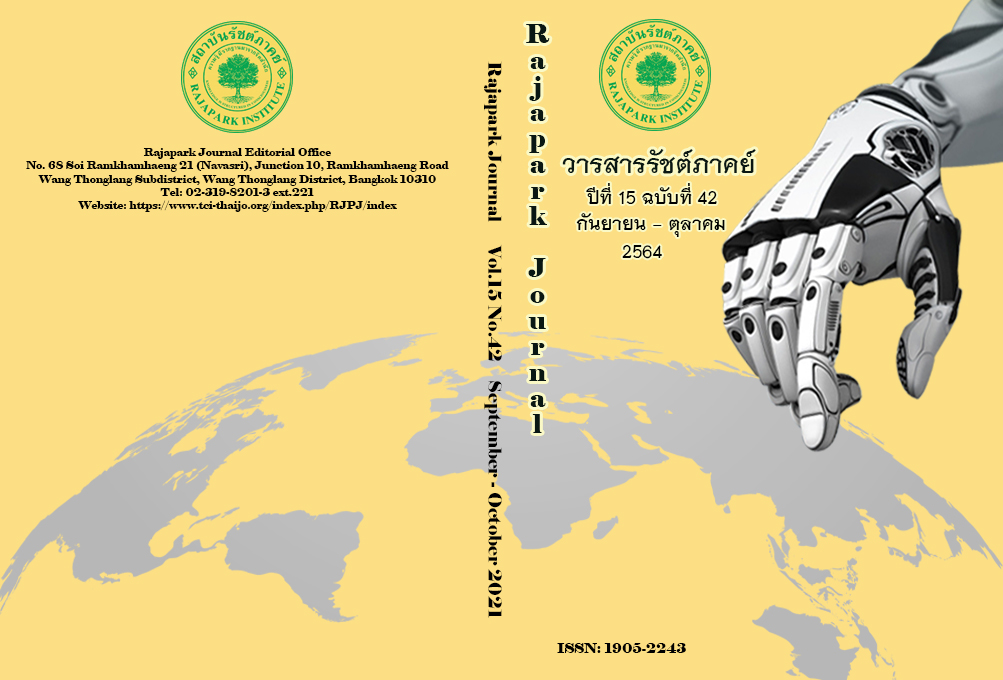Comparison of Thailand Competitiveness and Foreign Direct Investment with High Potential ASEAN Countries
Main Article Content
Abstract
The study aimed to describe and compare competitiveness and foreign direct investment (FDI), including designating discriminant variables among Thailand, Singapore, Vietnam, Indonesia, and Malaysia from 315 samples selected by a stratified and simple random sampling method. Data collected via a reliability-tested questionnaire (Cronbach's Alpha = 0.927) was analyzed by multivariate analysis of variance and discriminant analysis. The findings significantly revealed differences in competitiveness and FDI (indicated by Pillai's Trace, Wilks' Lambda, Hotelling's Trace, Roy's Largest Root = 0.000) among Thailand, Singapore, Malaysia, Indonesia, and Vietnam. Additionally, through discriminant analysis, there are 2 groups that could be classified by variables of competitiveness and FDI into higher capacity countries (Thailand and Singapore), and the lesser (Vietnam, Indonesia, and Malaysia).
Article Details
Views and opinions appearing in the Journal it is the responsibility of the author of the article, and does not constitute the view and responsibility of the editorial team.
References
Ariff, M., & Lopez, G. P. (2012). Outward FDI from Southeast Asia: The Malaysian Experience. In Rajan, R.S., Kumar, R., & Virgill, N. (Eds.). New Dimensions of Economic Globalization (Pp. 251-284). Singapore: World Scientific.
ASEAN Secretariat. (2007). AEC Blueprint 2007. Jakarta: ASEAN Secretariat.
ASEAN Secretariat. (2015). AEC Blueprint 2025. Jakarta: ASEAN Secretariat.
Chang, S. C., & Tsai, P. H. (2016). A Hybrid Financial Performance Evaluation Model for Wealth Management Banks Following the Global Financial Crisis. Technological and Economic Development of Economy, 22(1), 21–46.
Chung, T. W. (2016). A Study on Logistics Cluster Competitiveness Among Asia Main Countries Using the Porter’s Diamond Model. The Asian Journal of Shipping and Logistics, 32(4), 257–264.
Dunning, J. (1980). Toward an Eclectic Theory of International Production: Some Empirical Tests. Journal of International Business Studies, 11(1), 9-31.
Dunning, J. (2001). The Eclectic (OLI) Paradigm of International Production: Past, Present and Future. International Journal of the Economics of Business, 8(2), 173-190.
Dunning, J., & Lundan, S. (2008). Institutions and the OLI Paradigm of the Multinational Enterprise. Asia Pacific Journal of Management, 25(4), 573-593.
Fang, K., Zhou, Y., Wang, S., Ye, R., & Guo, S. (2018). Assessing National Renewable Energy Competitiveness of The G20: A Revised Porter’s Diamond Model. Renewable and Sustainable Energy Reviews, 93, 179–731.
Irfan, M., Zhao, Z. Y., Ahmad, M., & Mukeshimana, M. C. (2019). Critical Factors Influencing Wind Power Industry: A Diamond Model Based Study of India. Energy Reports, 5, 1222–1235.
Jeong, H.-G., Lee, B., & Pek, J. H. (2018). Factors Influencing ASEAN FDI and the Policy Implications. World Economy Brief, 8(21). http://hdl.handle.net/11540/8687
Mansur, K. B. H. M., Gope, J., & Afzal, M. N. I. (2017). An Investigation of National Innovation System Using Porter’s Diamond Model: An Empirical Study to Measure Competitiveness in ASEAN-5. Proceedings of International Conference on Economics, 183-198.
Masron, T. A., & Shahbudin, A. S. M. (2010). Push Factors of Outward FDI: Evidence from Malaysia and Thailand. Journal of Business & Policy Research, 51, 54-68.
Mongkol, K. (2017). Preventing the Transfer of Foreign Direct Investment in Thailand to ASEAN Emerging Market Competitors. Journal of Social Sciences, 20, 42-52.
Porter, M. E. (1990). The Competitive Advantage of Nations. New York: Free Press.
Punprasert, S., Mawongwai, Y., & Nilsom, W. (2019). Factor Influencing the Inflow of Foreign Direct Investment from Netherlands in the Food Processing Industry, Thailand. KHON KAEN AGR. J., 47(SUPPL.1), 877-882.
Purwanti, A., Java, K. P., & Genoveva, I. S. (2016). The Ability of Indonesia in Facing ASEAN Economic Community Market Competition. International Journal of Management and Applied Science, 2(6), 96-100.
Shobaruddin, M. (2018). Determinant Factors of Tuna Canneries Performance in Indonesia and Thailand: A comparative Perspective. Working Paper No. 03/ 2018. Thammasat Institute of Area Studies, Thammasat University.
Sjoholm, F. (2013). Foreign Direct Investments in Southeast Asia. IFN Working Paper No. 987. Stockholm, Sweden: Research Institute of Industrial Economics.
Sta. Maria, R., Urata, S., & Intal Jr., P. S. (Eds.). (2017). The ASEAN Economic Community into 2025 and Beyond. Jakarta: Economic Research Institute for ASEAN and East Asia.
Thailand Development Research Institute [TDRI]. (2017). Final Report: Thailand’s Trade and Investment Opportunities in ASEAN Countries. Bangkok: Udomviriya.
Transparency International. (2019). Corruption Perception Index. Berlin: International Secretariat.
UNCTAD. (2019). World Investment Report 2019. New York: United Nations.
World Bank. (2019). Doing Business 2019. Washington DC: World Bank.
World Economic Forum [WEF]. (2019). Global Competitiveness Report 2019. Geneva: WEF.


